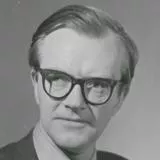
Maurice Wilkins FRS
Nobel Prize in Physiology or Medicine 1962
Biography
Awarded the Nobel Prize in 1962, Maurice Wilkins (1916–2004) played an important role in the discovery of the double helix structure of DNA whilst working at King’s.
Maurice was hard at work completing his PhD at the outbreak of World War II. During the war he worked to improve radar technology before changing to focus on isotope separation, important for the development of the atomic bomb. He and his team later moved to Berkeley, California to work on the Manhattan Project.
Following the war he returned to the UK, first to St Andrews University and then as the Assistant Director of a new biophysics unit at King’s, for which his former doctoral supervisor, John Randall, had secured funding. Whilst at King’s, Maurice began developing new types of microscopes and cameras. He and graduate student Ray Gosling used X-ray diffraction (a technique that uses the scattering of x-rays to investigate the structure of materials) to take new images of a form of the DNA molecule. Rosalind Franklin, who arrived at the university in 1951, built on Maurice’s work to take the famous ‘Photograph 51’. This was the image that demonstrated the helical structure of DNA and enabled James Watson and Francis Crick to build the first model of the molecule.
Wilkins and his colleagues spent seven years verifying the hypothetical model that Watson and Crick constructed. It was for this, as well as his initial work on X-ray diffraction, that Wilkins was awarded the Nobel Prize for Physiology or Medicine, together with Crick and Watson, in 1962. Rosalind Franklin could not receive the award as the committee does not consider posthumous nominations.
Maurice remained at King’s for the rest of his career. He was made a Fellow of the Royal Society in 1959 and awarded a CBE in 1963. He died in 2004 whilst still an Emeritus Professor at the university.
Did you know? Maurice wrote about the guilt he felt about the Manhattan Project and the bombs dropped on Japan. After the war he became involved with the Campaign for Nuclear Disarmament and campaigned widely for the socially responsible use of science. He was President of the British Society for Social Responsibility in Science from 1969–91.
